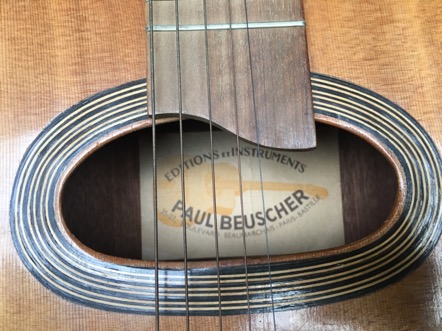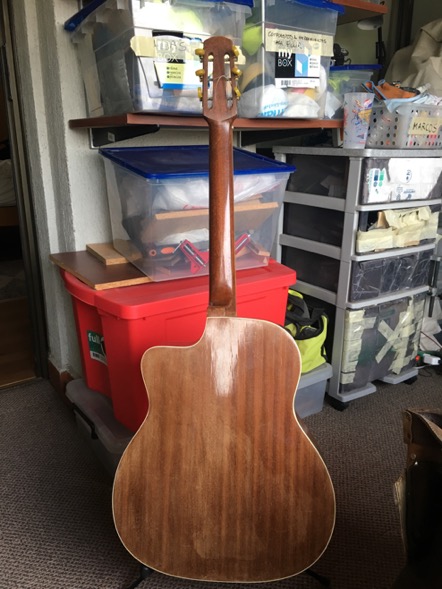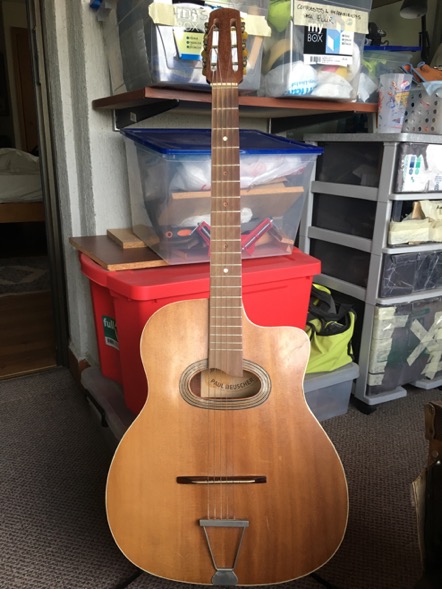DjangoBooks.com
Welcome to our Community!
Categories
- 20K All Categories
- 1.1K General
- 476 Welcome
- 59 Archtop Eddy's Corner
- 146 CD, DVD, and Concert Reviews
- 384 FAQ
- 26 Gypsy Jazz Italia
- 26 Photos
- 202 Gypsy Picking
- 21 Unaccompanied Django
- 15 Pearl Django Play-Along Vol.1
- 17 Gypsy Fire
- 45 Gypsy Rhythm
- 1.4K Gypsy Jazz University - Get Educated
- 130 Gypsy Jazz 101
- 224 Repertoire
- 218 History
- 707 Technique
- 51 Licks and Patterns
- 6 Daniel Givone Manouche Guitare Method Users Group
- 20 Eddie Lang Club
- 1.3K Gypsy Jazz Gear
- 801 Guitars, Strings, Picks, Amps, Pickups and Other Accessories
- 457 Classifieds
- 49 Recording
- 62 Other Instruments
- 18 Violin
- 5 Mandolin
- 22 Accordion
- 7 Bass
- 10 Woodwinds
- 347 Gypsy Jazz Events
- 143 North America
- 109 Europe
- 95 International
In this Discussion
Who's Online (0)
Paul Beuscher guitar maybe a Castelluccia?
Hi Gipsy jazz fans!
Thanks for all the information found here regarding Gipsy Jazz guitars and passion for it!
I've been in Paris recently and found an intriguing guitar, which maybe a Castelluccia D Hole done for Paul Beuscher in the 50s, basically checking in the descriptions done by Craig Bumgarner: It has a thick top in excess of 3mm, maybe 3.5mm, the fretboard width is 47mm at the nut, it has the yellow tuners from Delaruelle. And is pretty bowed needing a truss rod and a new fretboard and probably bridge. I would like your help in finding out three things:
1.- if it is really a Castelluccia or from other luthier?
2.- Which kind of wood would be better for the fretboard and bridge : Rosewood or ebony?
3.- Would you recommend to install the truss rod pointing back at the headstock or better inside the body?
Here are some fotos of the guitar.
Many thanks and happy playing!
Marcos













Comments
Hi Marcos
I've used a pair of carbon-fibre truss-rods in the necks on a couple of gypsy guitars I've restored.
I removed fretboard, straightened out the bowed necks using heat, then routed channels for the rods and epoxied them in (one side at a time, while clamping the other length of neck flat)
You should be able to re-use the fretboard, maybe even the frets. Drill 1mm register-pin holes through fretboard before you steam it off, to help relocate.
I don't think an 'ordinary' adjustable truss rod will work in this old guitar.
"HTH"
-Andy-
Many thanks Andy!
I'll follow your advice, I've done a similar work for a Fender P Bass with a broken truss rod, but never thought of epoxying the new truss rod in. And the register pin holes are brilliant. Regarding the fretboard, it seems made of some wood not that good, but it might be a good idea to keep it.
I was thinking of using this double action truss rod, to adjust it from the inside of the guitar.
Why you think an ordinary truss rod would not fit the bill?
Thanks again!
Marcos
I think you could do a conventional T rod, but need to plan how it interacts with the top & neck joint & how you'll get access at the head or through the soundhole
one of my guitars had a torsional twist in the neck, as well as a bow, so i wanted 'twin' truss rods to stabilise it, - the same guitar had a 3-part laminated neck, and I was worried I'd reduce strength if I took out most of the middle section of the three. I opted for a cheap & invisible option, the necks are flat, untwisted, and we're not looking for super-low action on these GJ guitars, imho.
Your fretboard - possibly rosewood or fruitwood e.g. pear- may clean up nicely with some fine sanding & oiling, I recut fret slots and refretted both of mine, & added new inlays.
Please bear in mind I'm very inexperienced compared to many of the luthiers & repair-people on this forum, so others will have different ideas and better advice. Good luck
p.s. "Henri Miller" is another luthier to consider for your guitar. Looks nice ;-)
Pata, I think Andy is talking about carbon fiber rods (not adjustable truss rods).
I don't think it's advisable to epoxy in adjustable truss rods or they won't be adjustable any more especially the dual acting ones.
The work you are talking about is fairly advanced repair procedure and you probably should have an experienced repair tech with knowledge of this procedure do this work.
Many thanks Andy for your clarifications. This guitar doesn't have a torsional twist, I've already detached the fretboard and indeed it looks like fruitwood. Also, the neck, back and sides are walnut.
Thanks Bones for your advice, I'm not planning to put epoxy in the truss rod, and probably I will be using a conventional single action one because the neck is just 15mm high without the fretboard. I promised not to screw up this beauty, I'll go as far as I feel comfortable doing, I've worked before in old archtop Gibsons and many acoustic spanish guitars, double basses, electric basses, electric guitars, charangos & harps. More important, all of them has been successful repairs!
Looking into the beautiful guitars from Craig Bumgarner, I found out that he uses mostly ebony for fretboards, which should give more stability and defined sound to the guitar, in particular for a 1934 Selmer Maccaferri copy presented in may 2019 (also walnut wood for neck, back & sides) he uses an ebony fretboard, so I'll do the same eventhough the actual fretboard is in perfect conditions. I'm wondering if the body of this guitar is a left over from Selmer that Castelluccia used for the Paul Beuscher deal. It has just three braces and a very thick top and the neck joint is very small, the dovetail barely there. Is amazing the neck can get so solid with such a light junction.
During the weekend I'll send some pictures of the guitar & process.
Thanks Bones & Andy!
Oh ok just wasn't sure if you had any experience. Yeah send pics and keep us posted.
How did you get the board off?
IMO it does look like a Castelluccia, very similar to one I have and they did supply Beuscher. I would agree with Andy's twin carbon rods idea, easier to do and they will keep it straight so no real need for an adjustable rod. Yes the fretboard is often pearwood, not great but often they used whatever they could get. If it comes off clean and in one piece you may be able to reuse it, much simpler than making a new one, and ebony would be much harder to work with. If the Delaruelles are all good then keep them for originality, I have some that work ok, but if they are worn or broken I replace with Schaller Deluxe covered tuners, much better. Keep us posted.
Hi Bones, I took the fretboard off with heat, it came out pretty nicely. During the weekend I worked on getting the neck as straight as possible without overdoing the wood. It was badly bowed, now it has a 2 mm bow, which I think I can correct with the truss rod. I'll route the truss rod channel during the week. I'm also working on the new ebony fretboard, here I would like your advice: The new fretboard is 9mm thick, compared with 7mm of the old one. The neck is 150 mm thick, so I think it would be ok to leave it at 9mm, it would brighten up the sound and make it stiffer (and heavier). Would I rather bring it down to 7mm?.
Thanks Chris for your comments, the Delaruelles are in perfect condition, I will keep them.
I don't have a twin carbon rod, I'll see if I can find one but probably I would need to bring it from the US and it will take time (I live in Chile, southern cone). If that's the case, I'm planning to use a normal truss rod pointing to the body, since the headstock junction to the neck is fairly narrow and aesthethically I think it will look bulky. But I'll try to get first the carbon one, against my desire to finish it asap.
Here are a couple of photos of the fretboard coming off and minimizing the neck bow.
Thanks!
1/ slot-cutting guide-table for full-size router ( with neck on guitar body, left) , and
2/ epoxying in one of the two CF rods, with neck clamped against aluminium straightedge.
(neck detached for reset & bolt-on conversion)
I soon learned to put masking tape along the side of the aluminium, which got some glue on it - Duh ;-)
Got lots of pics & clips of the Bucolo & Musicalia restos, I must put a youtube video together soon. -A-